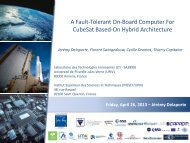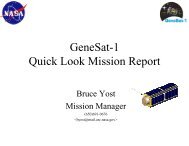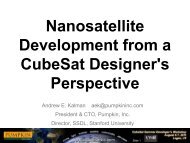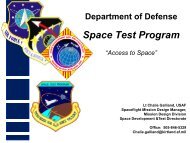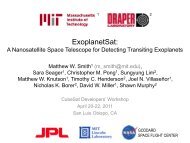Create successful ePaper yourself
Turn your PDF publications into a flip-book with our unique Google optimized e-Paper software.
<strong>The</strong> <strong>Firefly</strong> <strong>Mission</strong><br />
Understanding Earth’s most powerful natural particle<br />
accelerator<br />
D. Rowland <strong>CubeSat</strong> Developers’ Workshop April 22, 2009<br />
Wednesday, April 22, 2009<br />
1
<strong>The</strong> <strong>Firefly</strong> Team<br />
D. Rowland <strong>CubeSat</strong> Developers’ Workshop April 22, 2009<br />
Wednesday, April 22, 2009<br />
2
•<br />
•<br />
•<br />
•<br />
•<br />
•<br />
•<br />
D. Rowland<br />
Wednesday, April 22, 2009<br />
Mysterious TGFs<br />
<strong>The</strong> Earth as a source of gamma rays?<br />
Lightning as an antimatter factory<br />
Lightning source for inner belt electrons?<br />
Why and how does lightning occur?<br />
Does all lightning produce energetic radiation?<br />
What about other planets?<br />
How does activity in the troposphere affect the<br />
chemistry and plasma populations at 80-100 km?<br />
<strong>CubeSat</strong> Developers’ Workshop April 22, 2009<br />
3
D. Rowland<br />
Terrestrial Gamma ray<br />
Flashes (TGFs)<br />
Initial Observation by BATSE / CGRO (Fishman et al., Science, 1994)<br />
Wednesday, April 22, 2009<br />
•Coming from nadir (Earth source)<br />
•Much shorter than cosmic Gamma-Ray<br />
Bursts (~1 ms vs. 1-100 s)<br />
•Much harder spectrum than cosmic GRB’s<br />
(break at 30 MeV vs. 250 keV, power law<br />
slope -1 vs. -2)<br />
•Momentarily brighter than solar flares<br />
•Suggestive evidence for thunderstorm<br />
source<br />
•Bremsstrahlung radiation from energetic<br />
electrons - accelerated from thermal<br />
energies to tens of MeV in ~1 ms<br />
•fundamental process that may be<br />
implicated in all lightning discharges<br />
•may provide weak but continuous source<br />
of energetic electrons for Earth’s<br />
radiation belt<br />
<strong>CubeSat</strong> Developers’ Workshop April 22, 2009<br />
4
TGF / lightning relationship<br />
08811 CUMMER ET AL.: LIGHTNING-TGF RELATIONSHIP L0<br />
olarity. After accounting for the speed of light propagation<br />
elay in the gamma rays (1.7 ms, assuming they originate at<br />
0 km altitude [Lehtinen et al., 1999] and propagate upward<br />
o the<br />
•RHESSI has revolutionized our<br />
satellite at 550–600 km altitude) and sferics, we find<br />
hat 13 understanding of the 26 TGFs occur of within TGFs: 3/+1 ms of individual<br />
ightning • Much strokes more common that than originate previously within thought 10° of the RHESSI<br />
ubsatellite • Evidence point for 35 MeV (11 electron of themsource areat within 15-20 km 6°) altitude and whose<br />
olarity can be unambiguously determined from our data.<br />
he precise event timing is not sensitive to the assumed<br />
0 •km 976 TGF events detected source to altitude; date (7 years) ±30 km altitude changes<br />
orrespond to TGF time changes of only ±0.1 ms.<br />
[7] Figure 1 shows one of the strongest examples of this<br />
orrelation. <strong>The</strong> top panel shows 0.5 s of VLF-ELF mag-<br />
• Approximately 15/month detected (better triggering / detection algorithm)<br />
• RHESSI has 20 MeV stopping power, and sees TGF gammas of this energy<br />
Association with lightning-producing regions<br />
(Smith et al., Science, 2005)<br />
etic field data around the time of a TGF recorded<br />
y RHESSI on 22 October 2004, 04:33:32.234 UT. <strong>The</strong><br />
agnetic field component shown is the azimuthal compoent<br />
assuming a coordinate system origin at the RHESSI<br />
ubsatellite point at 15.09°N, 84.85°E (2390 km from the<br />
ensors). <strong>The</strong>re is a clear sferic at almost exactly the same<br />
ime as the TGF, as well as some much smaller signals<br />
istributed throughout the period. <strong>The</strong> lower panel shows<br />
he 10 ms around the lightning and TGF times, where the<br />
peed • Low-mid of light latitudes, propagation suggestive times of of thea need gamma for rays and<br />
ar (bottom).<br />
fericthunderstorm have been subtracted, activity assuming and high that tropopause both originate heightat<br />
he •subsatellite Most common point. near In this thunderstorm case the TGF production occurs 1.7 areas<br />
amma rays have also travel along field lines in the magnetosphere: ms<br />
erclouds and at ground <strong>The</strong>y may interact in the magnetically conju-<br />
efore the lightning stroke. <strong>The</strong> detailed event timing and<br />
d triggered lightning gate point of Earth_s atmosphere (16), may<br />
ration mplications of electrons D. Rowland are to analyzed populate the inner in more radiationdetail belt (17), inand Section 3.<br />
c fields above thunder- may be directly detectable from satellites.<br />
[8] <strong>The</strong> downward initial polarity in Bf of the filtered<br />
n 1925 by Wilson (6), BATSE recorded somewhat less than one<br />
ss Wednesday, LF was recently waveform April shown 22, 2009<br />
TGF unambiguously per month, when a trigger implies criterion was that the stroke<br />
during each recorded TGF, plotted over (i) the expected distribution of observed TGFs if the population were evenly distributed<br />
e scale in fraction of maximum exposure (top); and (ii) long-term lightning frequency data (29), with the scale in flashes per<br />
from the entire mission, and the analysis is<br />
ongoing. <strong>The</strong> RHESSI TGFs range from 0.2<br />
to 3.5 ms in duration and contain from 17 to<br />
101 detected photons. Sometimes two RHESSI<br />
flashes are detected from a single geographic<br />
region, either during one satellite pass (in one<br />
case 15 s apart) or separated by a full space-<br />
Lightning detected remotely,<br />
associated with a RHESSI TGF<br />
(Cummer et al., JGR, 2005)<br />
• Ground-based VLF receivers detect sferic<br />
from lightning within a few ms of one of the<br />
RHESSI TGFs<br />
• Several ms uncertainty in relative timing<br />
• Many TGFs occur “out of sight” of groundbased<br />
arrays<br />
timing uncertainty<br />
on February 6, 2008<br />
Figure 1. A lightning-TGF correlation example from<br />
October 2004, 04:33:32.234 UT. (top) One-half secon<br />
VLF-ELF data showing a clear large sferic near the<br />
time. (bottom) <strong>The</strong> precise timing relationship of<br />
lightning and TGF.<br />
www.sciencemag.org<br />
those that were clearly connected to a lightning strok<br />
fact, one of these is among the strongest and longest T<br />
<strong>CubeSat</strong> Developers’ Workshop April 22, 2009<br />
5
Electric fields in thunderclouds: consistent with<br />
Runaway Breakdown<br />
(positron / gamma feedback and MeV electron avalanche)<br />
D. Rowland<br />
Wednesday, April 22, 2009<br />
M. Stolzenburg et al. , GEOPHYSICAL RESEARCH LETTERS, VOL. 34, L04804!<br />
<strong>CubeSat</strong> Developers’ Workshop April 22, 2009<br />
6
Region of<br />
significant<br />
TGF<br />
occurrence<br />
D. Rowland<br />
Wednesday, April 22, 2009<br />
Radiation Belt Access<br />
X. Shao<br />
<strong>CubeSat</strong> Developers’ Workshop April 22, 2009<br />
7
D. Rowland<br />
How bright<br />
Brightness<br />
are<br />
distribution cuts<br />
they?<br />
off sharply around RHESSI's<br />
Fs observed during a single pass over a single storm:<br />
Wednesday, April 22, 2009<br />
For dessert:<br />
RHESSI cannot discriminate background<br />
fluctuations from TGFs at low fluxes<br />
(from Smith et al., SCIPP seminar, 2005)<br />
RHESSI Instrument saturates at high count rates.<br />
Possibly underestimating TGF fluxes by 2-5.<br />
sensitivity limit for our triggering algorithm; is this the<br />
tip of the iceberg?<br />
?<br />
10 6<br />
10 5<br />
10 4<br />
10 3<br />
10 2<br />
10 3<br />
RHESSI<br />
1 µs deadtime<br />
no deadtime<br />
0.1 µs deadtime<br />
<strong>CubeSat</strong> Developers’ Workshop April 22, 2009<br />
10 4<br />
10 5<br />
10 6<br />
8
•<br />
•<br />
•<br />
•<br />
•<br />
D. Rowland<br />
What do we need?<br />
Single platform that measures gamma rays, electrons, and lightning<br />
signatures<br />
• provides accurate relative timing<br />
• discriminates electron from gamma ray counts<br />
• uses VLF and optical signatures to discriminate weak TGFs from statistical fluctuations<br />
Accurate relative timing (1 µs)<br />
Accurate absolute timing to UTC (better than 1 ms)<br />
Fast detector: 1 MHz or (preferably) better<br />
Overflights of ground-based receivers for lightning characterization<br />
Wednesday, April 22, 2009<br />
<strong>CubeSat</strong> Developers’ Workshop April 22, 2009<br />
9
D. Rowland<br />
Instruments<br />
Gamma Ray Detector (GRD) measures:<br />
photons from 20 keV to 20 MeV, at count rates up to 1 MHz<br />
electrons from 100 keV to 10 MeV, at count rates up to 300 kHz<br />
“counts” up to 10 MHz<br />
snapshots, spectra, and count rate histograms<br />
VLF wave receiver (VLF) measures:<br />
single-axis electric fields 100 Hz to 20 kHz, up to 10 mV/m<br />
Optical photodiode (OPD) measures:<br />
four FOV light levels 100 Hz to 20 kHz, saturates above 98 %ile lightning<br />
provides localization of lightning to one of twelve regions (overlap of FOVs)<br />
can see lightning within about 400 km horizontal distance<br />
designed to work day and night<br />
Wednesday, April 22, 2009<br />
Postdischarge<br />
quasi-static<br />
electric field<br />
<strong>Firefly</strong> detects radio and<br />
optical signatures of lightning<br />
as well as the gamma-rays<br />
and energetic electrons.<br />
escaping MeV<br />
electrons<br />
VLF radio waves<br />
sprite emissions<br />
Thunderstorm<br />
runaway<br />
electron<br />
avalanche<br />
Lightning stroke<br />
bremstrahlung<br />
!-rays<br />
<strong>CubeSat</strong> Developers’ Workshop April 22, 2009<br />
650 km<br />
90 km<br />
60 km<br />
40 km<br />
15 km<br />
0 km<br />
10
D. Rowland<br />
Gamma Ray Detector<br />
“Phoswich” construction<br />
permits e - /photon<br />
discrimination<br />
Burle Planacon<br />
MCP<br />
10 cm x 10 cm x 1 cm BGO<br />
10 cm x 10 cm x 100 !m CaF 2 (Eu)<br />
" mm Aluminum shielding with reflective inner layer<br />
NADIR<br />
(TGF source)<br />
BGO and CaF2(Eu) have different light<br />
decay times (300 ns, 900 ns). By<br />
integrating the resulting charge signal with<br />
two different shaping amplifiers, the nature<br />
of the incoming radiation can be<br />
determined, and the energy can be<br />
measured by standard pulse-height analysis.<br />
Wednesday, April 22, 2009<br />
Development at NASA GSFC<br />
Graded-Z<br />
shield<br />
HV in<br />
BGO Scintillator<br />
Burle Planacon<br />
PMT 85001-501<br />
A=1<br />
2x Temp out<br />
A=4<br />
200 cm 2 x 1 cm thick scintillator<br />
Electrons 1 MeV interact in both<br />
signal read<br />
ECB<br />
Data out<br />
GRD Front-end<br />
pwr<br />
EPR<br />
2x Temp out<br />
Ramp volts<br />
Set volts<br />
Dis volts<br />
BGO Scintillator<br />
Burle Planacon<br />
PMT 85001-501<br />
<strong>CubeSat</strong> Developers’ Workshop April 22, 2009<br />
A=1<br />
A=4<br />
HV in<br />
11
D. Rowland<br />
Wednesday, April 22, 2009<br />
VLF receiver<br />
Development at Siena College<br />
Measure electric field signatures in the range of 100 Hz to 1 MHz<br />
User selectable anti-aliasing filter of 30 kHz, 180 kHz, and 1080 kHz.<br />
1.6 m tip-to-tip electric dipole antenna<br />
Dual, multiplexed 6 MHz Stanford ADCs for all science instruments<br />
We gratefully acknowledge collaboration with Stanford University.<br />
Time-tag VLF events for ground-based VLF correlation<br />
Primary goal is 1ms timing accuracy to UTC.<br />
Secondary goal is 1us timing accuracy to UTC.<br />
<strong>CubeSat</strong> Developers’ Workshop April 22, 2009<br />
12
D. Rowland<br />
Optical Photodiodes<br />
• Development at Siena College<br />
• Bobby Carroll, John DeMatteo, Jennifer Williams<br />
• Al Weatherwax, Joe Kujawski, Michele McColgan<br />
• FOV Calculations<br />
• Minimum and maximum field of view were calculated based on the<br />
geometry of the photo detector and collimator<br />
• <strong>The</strong> square photodetector was modeled as two circles:<br />
• inscribed (min)<br />
• circumscribed (max)<br />
• Equations developed using geometric models and implemented in Matlab<br />
Wednesday, April 22, 2009<br />
<strong>CubeSat</strong> Developers’ Workshop April 22, 2009<br />
13
• Mass: 4.5 kg<br />
• Power: 3 W orbit-averaged<br />
• Comm: 425 MHz<br />
• 19.2 kbps downlink<br />
• GPS for accurate timing to UTC<br />
• Gravity gradient boom and<br />
magnetotorquers for attitude control<br />
• 3-axis attitude magnetometer and solar<br />
cell measurements for attitude<br />
determination<br />
• points within 30 degrees of nadir<br />
• attitude knowledge requirement 10<br />
degrees<br />
• 1 µs accuracy to UTC<br />
• 2 GB onboard storage<br />
D. Rowland<br />
Wednesday, April 22, 2009<br />
<strong>The</strong> spacecraft<br />
Development at the Hawk Institute for Space Sciences<br />
GRD sensor<br />
(1 of 2)<br />
Four-channel<br />
photometer<br />
VLF antenna<br />
(1.6 m tip to tip)<br />
Comm antennas<br />
<strong>CubeSat</strong> Developers’ Workshop April 22, 2009<br />
14
•<br />
•<br />
•<br />
•<br />
•<br />
•<br />
•<br />
Operations concept<br />
Prime data are 100 ms “snapshots” triggered by increase in<br />
gamma ray counts, electron counts, VLF signal, or optical signal<br />
trigger levels adjustable from ground<br />
expect ~50 snapshots per day<br />
expect 1-5 weak TGFs / day, 1 strong TGF every 2-3 days<br />
Duty cycle of about 50% to save power (on during eclipse)<br />
ground contacts only 8x5, during business hours<br />
Ramp down HV in South Atlantic Anomaly<br />
D. Rowland<br />
Wednesday, April 22, 2009<br />
<strong>CubeSat</strong> Developers’ Workshop April 22, 2009<br />
15
Student involvement - Siena<br />
D. Rowland<br />
Wednesday, April 22, 2009<br />
J. Williams, J. DeMatteo, R. Carroll<br />
working with A. Weatherwax, J. Kujawski, M. McColgan, E. Breimer, R. Yoder<br />
AWESOME VLF Receiver<br />
Ground-based VLF support.<br />
Already in progress.<br />
GSE MATLAB Instrument Control Toolbox<br />
Instrument modeling<br />
Optical photodiode collimator optimization<br />
Data Processing and Analysis<br />
MATLAB<br />
LEGO <strong>Firefly</strong> <strong>Mission</strong><br />
Experiment Expansion Modules<br />
FFT, Filter bank, advanced triggering<br />
Geographic Information System<br />
Worldwide lightning network<br />
<strong>CubeSat</strong> Developers’ Workshop April 22, 2009<br />
16
Student involvement - UMCP<br />
Prototyping the detection electronics<br />
Testing the GRD front-end electronics<br />
GSE SW for configuring instrument<br />
D. Rowland<br />
S. Kholdebarin, L. Ramsey<br />
Characterizing High Voltage Power Supply<br />
Input<br />
Pulse<br />
Charge Sensitive Preamp<br />
Fast Shaper<br />
Slow Shaper<br />
Wednesday, April 22, 2009<br />
<strong>CubeSat</strong> Developers’ Workshop April 22, 2009<br />
17
Student involvement - UMES<br />
•<br />
•<br />
•<br />
D. Rowland<br />
Wednesday, April 22, 2009<br />
UMES students are taking a class in spacecraft systems<br />
taught by Hawk personnel.<br />
1-3 UMES students will intern at Hawk over the next<br />
year, assisting with the spacecraft design and integration,<br />
and flight software and ground station testing<br />
UMES students will mentor Pocomoke High students in<br />
operating the ground station<br />
<strong>CubeSat</strong> Developers’ Workshop April 22, 2009<br />
18
•<br />
•<br />
•<br />
•<br />
•<br />
•<br />
•<br />
D. Rowland<br />
Wednesday, April 22, 2009<br />
Schedule<br />
Project start: Sept 18, 2008<br />
<strong>Mission</strong> Requirements Review: Jan 12, 2009<br />
Design Review: June, 2009<br />
Experiment Integration: January 2010<br />
Spacecraft level environmental testing: Feb / March 2010<br />
PPOD environmental testing: April 2010<br />
Launch: August 2010<br />
<strong>CubeSat</strong> Developers’ Workshop April 22, 2009<br />
19
D. Rowland<br />
Status<br />
• Successful <strong>Mission</strong> Requirements Review in Jan 2009<br />
• Prototyping instruments<br />
• Flight software and mechanical design underway<br />
• Procurements for commercial subsystems underway<br />
• Attitude Control System design underway<br />
Wednesday, April 22, 2009<br />
<strong>CubeSat</strong> Developers’ Workshop April 22, 2009<br />
20
D. Rowland<br />
Wednesday, April 22, 2009<br />
http://firefly.gsfc.nasa.gov<br />
<strong>CubeSat</strong> Developers’ Workshop April 22, 2009<br />
21



